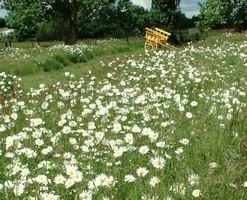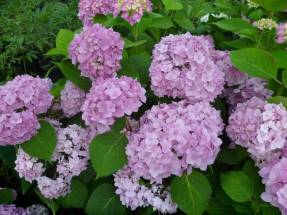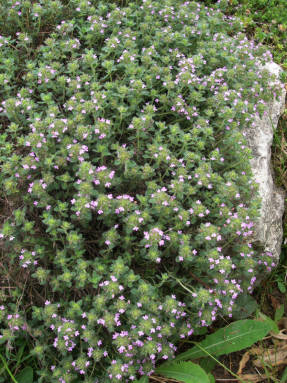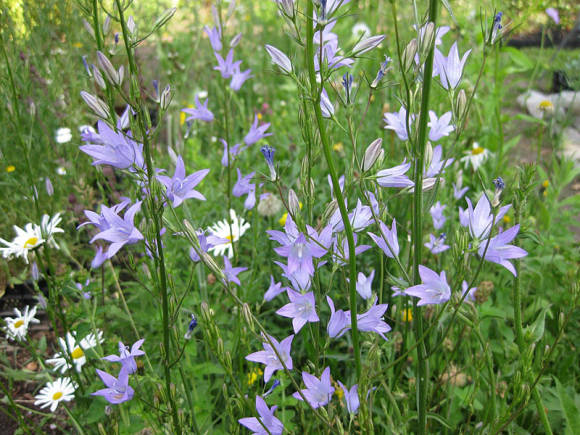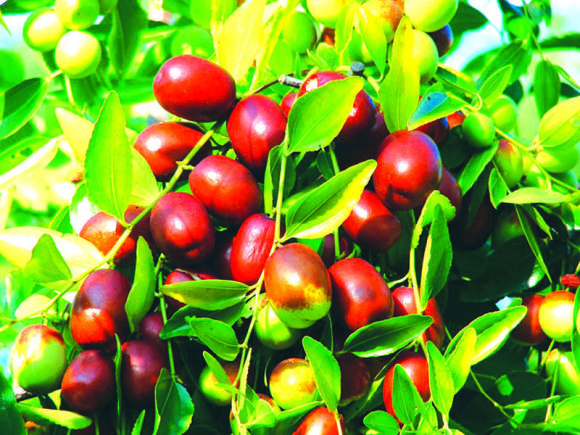Genus woodcutter, or red-bubble (Celastrus)belongs to the euonymus family. It contains about 30 species that live in East and South Asia, America and Madagascar. In Russia (in the Far East), 3 species grow.
All wood-nose pliers belong to the vines, firmly wrapped around the support counterclockwise. Rigid, conical, slightly bent down buds are distinguished by high tenacity, which contributes to the capture and retention of growing shoots on a support. Literally piercing the trunks of trees, the powerful lashes of the wood-nose are capable of destroying a tree growing nearby, which is why the plant got its name. The flowers of the woodworm are small and inconspicuous, medium-sized tricuspid fruits - capsules are also characterized by greater decorativeness. With abundant fruiting, their bright yellow, slightly wrinkled valves are especially expressive. The fruits are elegant when, when the valves are apart, their red seedling (arillus) is shown. Usually fruits contain 3 seeds, less often 1-6 seeds.
 |
The most resistant and often found in culture is the round-leaved woodworm (Celastrusorbiculata). Its natural range is located in the southern part of the Far East and in the south of Sakhalin, as well as in Japan, Korea and Northeast China. In nature, this species grows in the coastal zone on rocks and stony slopes, as well as in river valleys on sandy-pebble deposits and is found on the edges of sparse deciduous forests on loamy soil. In Moscow, woody liana reaches a length of 6 m, in nature - more than 12 m. The thickness of a strong stem is from 3 to 8 cm. Already at the base of the soil, the plant branches and has 2-3 stems. But stronger branching occurs in the upper part of the vine, from where more than 10 young shoots spiral upward every year. The bark of young shoots is reddish or brown, with numerous grayish lenticels. On old stems, the bark is gray, with longitudinal and oblique cracks. The species is characterized by shoots with a white core inside.
Buds are rigid, broadly cone-shaped, 1.5-3 mm long, brown at the top, lighter at the base. They, like prickly hooks, help the spirally curling shoot to grip and hold the support. If there is no support that could be wrapped around, then the shoots are able to gain a foothold on a flat vertical wall and then remain straight for up to 3 m.
Leaves are usually round (up to 12 cm long, 2-7 cm wide), as indicated by the name of this species. However, the leaf shape can be broadly elliptical or obovate. The base of the leaf is wedge-shaped, often uneven; the apex is rounded, with a short cusp. The edge of the leaf is rounded-serrate, sometimes with calloused-thickened denticles. The leaves have filamentous brown stipules that subsequently fall off. Young leaves are bright green above and are very shiny; in autumn they turn lemon-yellow or yellow-green, at the end of October they fall off.
Flowers appear in June, flowering lasts 2 weeks. Small whitish-green flowers (6-7 mm in diameter) are collected in 3 pieces in axillary inflorescences - shields. Most often, the flowers are unisexual, but there are also bisexual flowers. The female flowers have a pistil with a three-celled ovary, a stigma at the level of the petals, the stamens are underdeveloped (1.5 mm long) and sterile. Male flowers have a sterile pistil and stamens (3 mm long) on thin filaments. The fruit is a spherical intense yellow capsule 8 mm in diameter with a pointed tip at the top. From the opened fruit, a reddish arillus is visible, divided by grooves into 3 parts. Seeds are yellowish-gray, oblique in shape. Weight of 100 fruits -16 g. Weight of 1 thousand seeds - 8.0-9.5 g. Flowering and fruiting of plants begins from the age of 5.
 |  |
The round-leaved woodworm is a liana, valuable for decorative gardening, in the absence of any support, the shoots spread along the ground. In culture since 1860
 |
Another species originating from the Far East (Amur Region, Khabarovsk and Primorsky Territories) is the lash-nose plier (Celastrus flagellaris), also growing in northern China, Korea and Japan. Liana is able to climb to a height of up to 10 m, sometimes it does not twine around a tree, but climbs it straight up. Rigid hook-shaped kidney scales, which, like thorns, pierce the bark of a tree growing nearby, help to hold on to the twisting stems of the vine. It is interesting to note that a mass of adventitious roots is formed at the points of contact between the wood-nose pliers and the trunk, which in the future can cause the death of the tree. Young shoots are light green with white lenticels, old ones are reddish-brown with longitudinal cracks. Unlike the previous species, the lash-nose pliersthe branches are hollow inside, the leaves are elliptical or ovoid, green on both sides, with a pointed tip and a wedge-shaped base, the edge of the leaf is not serrate.
These plants are dioecious, dioecious flowers are often solitary, less often collected in dichasia inflorescences. Male plants have small whitish flowers with stamens. On female plants subsequently (in August-September), fruits develop - flattened globular pale yellow capsules with a pointed tip at the top.
 |
This species can be used not only for vertical gardening, but also as a ground cover plant. It is known in culture since the beginning of the XX century, it is kept in the botanical gardens of Western Europe and North America.
Bristle-nose pliers (Celastrusstrigillosus) naturally grows in forests in the south of Sakhalin, on the Kuril Islands (Kunashir, Shikotan, Iturup) and in Japan. In nature, the liana reaches a length of 10 m, in Moscow - about 2.5 m. It, like the round-leaved wood pliers, has a solid white core inside the branches. The main differences of the species are, first of all, that there are no thorny buds, and the leaves are wrinkled due to the depressed, but protruding from below, veins. The leaves are elliptical or oblong-obovate in shape, 7-14 cm long, 4-8 cm wide. The leaf apex is pointed, the edge is crenate-serrate.
 |
Flowers are solitary, less often they sit in bunches on short pedicels. Flowering begins in the second half of June and lasts 10-12 days. Fruits-capsules are spherical, 7 mm in diameter, ripen in early October. Seeds have red-orange seedlings. Liana blooms and bears fruit from the age of 10. In culture, the species has been known since 1860.
 |
In thickets of bushes and sparse forests in the east of North Americatree-nose climbing dwells (Celastrusscandens), sometimes called American. Its whips rise to a height of 7 m. Branches with a solid white core, the bark on old stems is dark gray with oval and rounded lenticels. The buds are small, ovoid, with sharp, tenacious tips, bent outward. Leaves are ovoid, 4-12 cm long, 2-4 cm wide, with a pointed tip, wide-wedge-shaped base, finely serrate edge. In autumn, the leaves turn yellowish. The flowers are dioecious, collected in apical inflorescences - panicles up to 8-10 cm long. The petals are pale green with a whitish jagged edge. Flowering lasts about 3 weeks. Fruits are yellow capsules 8-10 mm in diameter, on seeds (4.5 mm in length) there are red seedlings. The plant blooms and bears fruit from the age of 7, gives a lot of root growth, which greatly facilitates its reproduction. The species has been known in culture for a very long time, since 1736 and is used to decorate the walls of buildings and fences.
 |  |
Because of woodworm paniculata (Celastruspaniculatum) heavily freezes in central Russia, it is almost unknown in our culture. This species originates from the Himalayas, grows in India, Burma, China and Indonesia. Its distinguishing feature is the presence of brown (not white!) Wood inside the branches, which are partially hollow. Leaves are ovoid, 5-12 cm long, up to 7 cm wide, green on both sides. The flowers are yellow-green, collected in a paniculate inflorescence 10-20 cm long. The fruits are yellow bolls, but the seedlings are crimson.
Spectacular liana - angular wood plier (Celastrusangulatus) is also not hardy in Russia.It comes from southeastern China, where it can climb to a height of 10 m. Dark brown ribbed shoots are densely covered with tuberous lenticels. Buds are cone-shaped with tight-fitting scales. Leaves are broadly elliptical, 9-18 cm long, 7-15 cm wide. Elegant paniculate inflorescences (10-15 cm long) with small dioecious whitish-yellow flowers. But the plant is especially noticeable during the fruiting period, when dense fruit panicles appear with bright yellow capsules (about 1 cm in diameter) and seeds with dark red seedlings. This decorative type has been known in culture since 1900, but has not found application in Russia due to its low winter hardiness. The species has been successfully tested in Abkhazia and Uzbekistan, where it blooms and bears fruit.
Features of cultivation and reproduction
 |
They prefer a sufficiently illuminated place; when shaded, they develop poorly and bear fruit worse. He is unpretentious to the soil, but loves fertile, loamy and sandy loam areas. Shoots on a vine grow very quickly, often they twine around each other, intertwining together over a considerable length.
These vines can be propagated by cuttings, root suckers, lignified and green cuttings. The most successful rooting is observed in green cuttings treated with a growth promoter.
They are easily propagated by seeds, the germination of which lasts 2-3 years. After harvesting, the seeds are dried at room temperature for 2-3 weeks. It is best to sow freshly harvested seeds "before winter", or in spring, but then cold stratification of seeds (at a temperature of 0 + 3 ° C) will be required for 2 months. Sowing seeds is carried out in rows; at a distance of 5 cm from each other and 10 cm between rows, the depth of planting seeds is 1.5-2 cm. The substrate for sowing is light fertile loamy soil. Seedlings appear 1 month after sowing. Seed germination is underground, i.e. elliptical cotyledons do not show above the soil surface.
 |
Photo by A.G. Kuklina, G.A. Firsova, V.V. Sheiko
